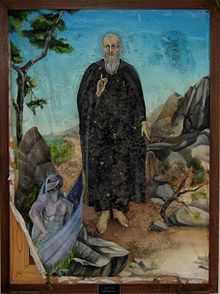- Nilus the Younger
-
- For the elder Nilus (died c. 430), see Saint Nilus.
Saint Nilus the Younger 
Portrait of Nilus, Sanctuary of San Nicodemo in Mammola, which is dedicated to Saint Nicodemus of Mammola.Abbot and Confessor Born 910 AD
Rossano, Byzantine Theme of Calabria (now Calabria, Southern Italy)Died December 27, 1005
Abbey of Sant'Agata, Tusculum, Latium, Papal StatesHonored in Roman Catholic Church
Eastern Orthodox ChurchMajor shrine Abbey of Grottaferrata, Province of Rome, Lazio, Italy Feast September 26 Saint Nilus the Younger (Italian: San Nilo di Rossano) (910 – December 27, 1005)[1] was an Italian saint.
Biography
Born to a Greek family of Rossano, in the Byzantine Theme of Calabria, for a time he was married (or lived unlawfully) and had a daughter. Sickness brought about his conversion, however, and from that time he became a monk and a propagator of the rule of Saint Basil in Italy.
He was known for his ascetic life, his virtues, and theological learning. For a time he lived as a hermit, later he spent certain periods of his life at various monasteries which he either founded or restored. He was for some time at Monte Cassino, and again at the Alexius monastery at Rome. When Pope Gregory V (996–999) was driven out of Rome, Nilus opposed the usurpation of Philogatos of Piacenza as antipope. Later when Philogatos was tortured and mutilated he reproached Gregory and the Emperor Otto III for this crime.
Nilus' chief work was the foundation in 1004 of the famous Greek monastery of Grottaferrata, near Frascati, on lands granted him by Gregory, count of Tusculum; he is counted the first abbot. The abbey continues in the Byzantine rite. He spent the end of his life partly in St. Agata monastery in Tusculum and partly in a hermitage at Valleluce near Gaeta.
He died in the Sant'Agata monastery in 1005. His feast is celebrated on September 26, in both the Byzantine Calendar and the Roman Martyrology.
Notes
- ^ The official site for the Abbey of Grottaferrata gives September 26
References
 This article incorporates text from a publication now in the public domain: Herbermann, Charles, ed (1913). "Nilus the Younger". Catholic Encyclopedia. Robert Appleton Company.Categories:
This article incorporates text from a publication now in the public domain: Herbermann, Charles, ed (1913). "Nilus the Younger". Catholic Encyclopedia. Robert Appleton Company.Categories:- 910 births
- 1005 deaths
- People from the Province of Cosenza
- People from Calabria
- Italian saints
- 11th-century Christian saints
- 10th-century Byzantine people
- Byzantine saints
Wikimedia Foundation. 2010.
